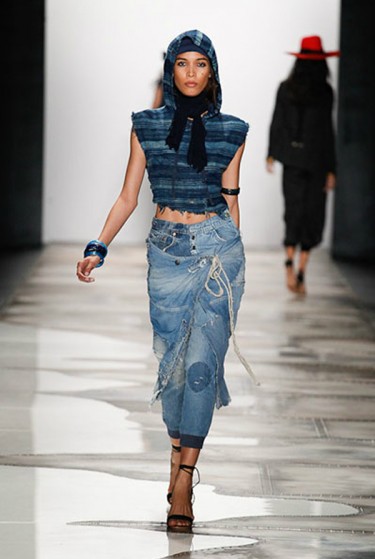
Greg Lauren
Greg Lauren’s eponymous collection of men’s and womenswear is made entirely from upcycled materials. With a focus on decommissioned military textiles.
Challenging the existing notion on vintage clothing, KUON revitalizes traditional Japanese boro. “Boro” being worn and used textiles and old, torn, or patched clothing in Japan. 150 years ago when cotton textiles were so valued that every scrap was saved and salvaged, and made beautiful again through a technique called Sashiko. Textiles were scarce and expensive in Japan, and completely unaffordable for peasants in rural areas. Cotton clothing was layered and top stitched for warmth, and strength. Remnants were patched together for work clothes, blankets and nightwear, then patched again as wear required. Never wasted, no matter how tiny the scraps, the patching and stitching resulted in complex, layered textiles of shredded and worn indigo dyed cotton and linen fragments. Textiles were considered so precious that they were handed down through generations, and repurposed from workwear to underwear, floor cloths and dusters, wrapping the stories of life across generations within them.
KUON reutilize these rich materials one more time, by repurposing them into contemporary Western clothing for men. Tailored men’s sports jackets form the basis of the line, with a rich variety of boro patchwork from heavily deconstructed, faded and worn, to deep indigo and minimally patched, with every combination in between, each entirely unique, and each featuring the iconic rich contrasting running stitching in rows and squares. Reveling in the history of people’s lives, KUON don’t simply repair boro, they create entirely new patterns from scratch, disassembling the textiles into pieces, only to reconstruct them artfully and turn them into modern men’s fashion. Messenger bags, flat caps, patched T-shirts, and machine stitched crisp white shirts augment the line. The collection was founded in fall of 2015 by Arata Fujiwara and Shinichiro Ishibashi in Tokyo, an apprenticed tailor, and pattern maker.
KUON means ‘eternity’, ‘remote’ ‘past’ or ‘future’, and ‘permanence’, a reflection of the brands aim to create permanent, simple authentic value, not bound by tradition. Addressing social issues through fashion, KUON reinvents the notion of vintage, revitalizing it with new value. Challenging the system of mass production and consumption with conscious and considered design, KUON produce lifestyle products that are stylish and purposeful. All the boro textiles are repaired by women in the Tohoku region of Japan, which suffered from the earthquake and resulting tsunami that devastated Japan in 2011. Each of the sashiko stitch masters mend, stitch and reconstruct the boro textiles, before they are cut into blazers. The Otsuchi-cho area of Japan where the boro is sent, is renowned for the sashiko tradition, with many of the masters in their 70’s, some even old enough to remember growing up wearing boro kimonos. The decision to work with these women was in an effort to continue this rich tradition and lineage.
The traditions and techniques that KUON clothing is built on, include Saki-ori, which is a cloth rewoven from recycled old rag weft and cotton warp. Ryuku-ai, a tradition of indigo dying in Okinawa, the southern most island of Japan where fermented indigo leaves are augmented with a local plant called Strobilanthes cusia, which results in a particularly rich deep color blue. Doro-zome, a natural dyeing technique from Amami Oshima, where yarn is dyed with a tree called sharinbai, then massaged in a large muddy puddle, causing a rich shinny texture. Finally Sashiko is a stitching technique started during the Edo period in the Tohoku region where the weather was too cold to grow cotton. Shasiko is a form of decorative stitching created to layer together textiles in an effort to make warmer and more durable garments to weather the severe winters.
Website: www.kuon.tokyo